WHAT IS SEA GLASS / BEACH GLASS?
“Sea Glass” is the general term used by beachcombers and collectors for pieces of weathered glass found along the shores of large bodies of water, including seas, oceans, large lakes, etc. The term “Beach Glass” is more or less synonymous with “Sea Glass”, but is more commonly used for glass found along inland rivers and other bodies of water where wave action is generally less intense, and as a result, the glass isn’t usually as heavily worn.
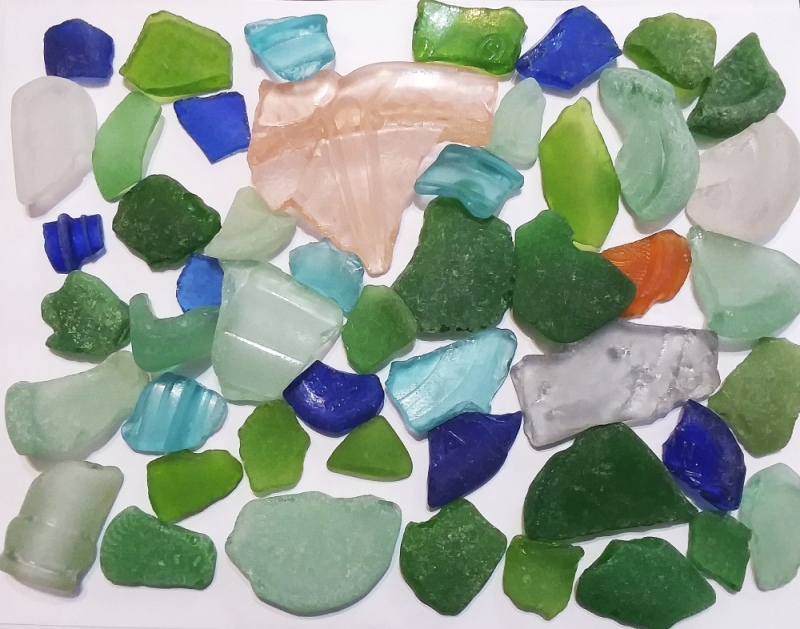
Sea glass gradually acquires a frosted or “matte” surface by exposure to long-continued surf action (numerous microscopic scratches caused by repeated abrasion by gravel and sand particles), but additionally in some measure by contact with the saline environment of ocean water.
Sea glass tends to be more smoothly worn, more rounded and pebble-like, with fewer markings still legible on individual pieces. Beach glass (from shores of inland rivers and lakes) is typically less worn, often with embossed markings that remain clear enough to help identify what type of item (bottle, jar, insulator, tumbler, plate, window pane, etc.) the glass was originally part of.
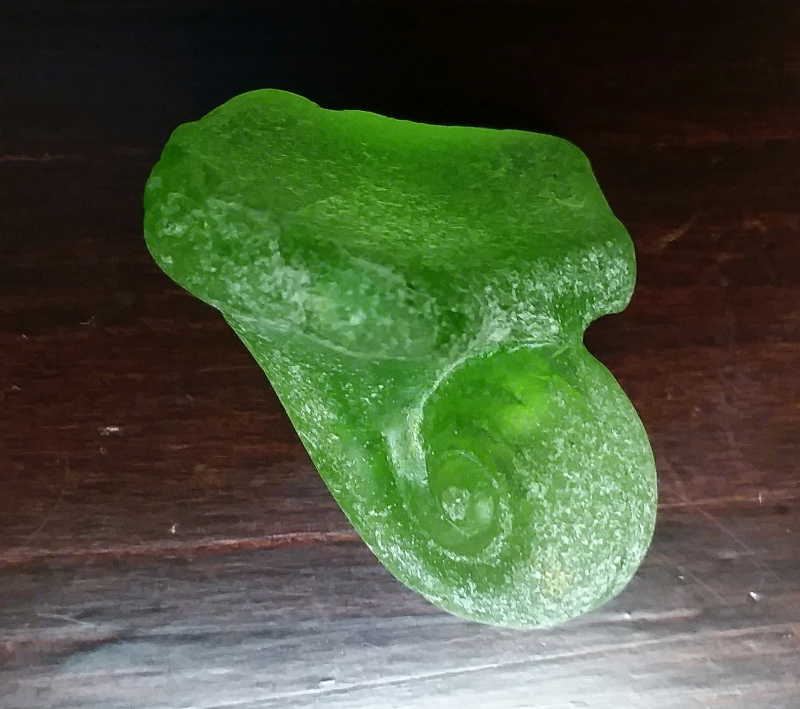
COLORS
The three most common colors of sea glass include clear (“flint” or “white”, used for innumerable common bottles and jars of every description, especially made within the last 70-100 years, window glass, tableware, etc.), emerald or lime green (typical of older Sprite, 7-up, ginger ale and other soda bottles), and shades of amber (including light orange amber, golden amber and medium brown or “beer bottle brown” glass.)
Less common are various shades of aqua (light to medium blue-green), which was the typical color of a good percentage of common bottles and jars made, in general, before the 1920s. Many older electrical insulators were made in some shade of aqua glass, ranging in depth from a very pale, “washed out” aqua to an intense dark “teal” aqua or dark green. Along Pacific Coast beaches, some aqua sea glass could theoretically result from broken glass fishing net floats.
ADVERTISEMENT
Other colors, less frequently found, include amethyst (very light to medium purple indicating the presence of manganese used as a decolorizer, very common in bottles from the 1890-1920 period); cobalt blue (Bromo-Seltzer bottles, Milk of Magnesia bottles, Noxema jars, Vicks VapoRub jars, many other products); forest green; sapphire blue; light blue; cornflower blue; olive green (Champagne and many other types of bottles); olive amber; kelly green; dark purple; light green and pink (Depression-era glassware); medium/dark turquoise or dark teal green (stoplight lenses for the “green light”); teal blue; light yellow or yellow amber (as used in Depression Glass); “straw” or very pale amber; peach; black glass (intense olive green or olive amber typically used for some beer, ale, bitters and whiskey bottles pre-1890); and white milk glass (salve, cosmetic & cold cream jars, bud vases, decorative tableware, and much more).
Other colors include gray (perhaps television faceplates or other tech/industrial glass products, some thick plate glass); purple black glass; true yellow; ruby red (vehicle taillight lenses, stop light lenses, railroad light lenses, upscale tableware, etc); cranberry red; and true orange, which is probably the least common glass color found in sea glass.
Occasionally, opaque colors are found, including purple slag (marbled white milk and opaque purple); green (“Jadeite”) and other colors. A specific color may be called different names by different persons, including some of the colors within the preceding list!!
Often, it’s difficult to be sure what a particular piece of sea glass came from, which adds to the mystery and fun of collecting. Many colors found in “old” glass are also being made in new items (such as various shades of green, olive amber and aqua that are used for various present-day wine, beer, soda, mineral water, olive oil and other types of bottles) so color alone may not help identify an age range for any particular piece of glass. In general, older bottles were made of heavier and thicker glass than present-day bottles. This is especially true of old soda and beer bottles. The presence of many bubbles is usually (but not always!) an indication of some age, as most glass before c. 1920 tends to have more bubbles in it than modern glass. In the case of modern “art glass” and other decorative glass, however, bubbles are often intentionally left in it for an attractive effect.
There are a multitude of minor color shades that are difficult to define. There are many shades of “off-clear” tending to lean, for instance, toward peach, straw, gray, green, blue, lavendar and other color directions. “Clear” bottle glass with a faint straw, peach or yellowish tinge was common in the 1910s-1940s as a result of the element selenium being added to the batch as a decolorizer.
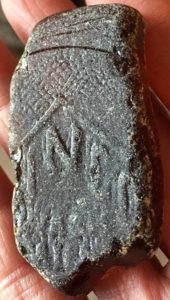
Although virtually any type of glass object might eventually wind up as a piece of sea glass or beach glass, a large percentage of this glass originates from containers thrown away in ordinary trash. A good percentage of these containers have washed into rivers (and ultimately, oceans and lakes) along with driftwood, plastic and other debris after rises in water levels as a result of heavy rains and/or melting snow.
Virtually every river carries floating debris after a marked rise, and oftentimes the bottles and other glass containers afloat on these bodies of water are carried along for hundreds of miles from their original source of deposition in headwaters (minor tributaries, streams and creeks located far inland) before they are eventually carried out to sea, and ultimately wash ashore. Winds and waves, combined with abrasion on rocky, gravel or sandy beaches starts the process of breaking up the bottles and they eventually wind up as “sea glass”. Sometimes bottles are smashed into pieces by mischievous children (and adults) playing along sea shores, and then the pieces are further weathered by wave action.
Some unknown percentage of sea glass originates from bottles thrown overboard from ships and boats, although I believe that is actually a rather small percentage, and in fact the majority of bottles cast up onto beaches (either ocean, estuary, sea or river beaches) come from trash washed from inland sources. It can also depend on the exact locality where the glass is found; the location and proximity of nearby rivers and their outflow currents; whether or not a beach is near a major shipping lane; how popular a particular beach is with tourists (who might leave trash behind such as wine bottles); the frequency of strong oceanic storms in a particular area, and many other factors.
ADVERTISEMENT
Sea glass /Beach glass that originates from “non-enclosed” (not floatable) glass objects may come from trash that was disposed of close to the actual place where it is eventually found. (Any bottle that has floated for long distances would have had the lid intact and tightly closed, otherwise it would have filled with water and sunk). Some areas along shorelines and beaches were once unofficial dumping areas – landfills or trash dumps, later to be uncovered by shifting beach erosion zones. In these cases, it is not that unusual to find, along with beach glass, worn sherds of pottery bowls and crocks, pieces of ceramic/china dishware, antique porcelain doorknobs, porcelain furniture caster wheels, white milk glass “Boyd” fruit jar lid liners/discs, small “spool type” or “cleat type” porcelain home inside-wiring insulators, marbles and other durable (non-perishable) related artifacts, remnants of typical household and/or construction-related trash.
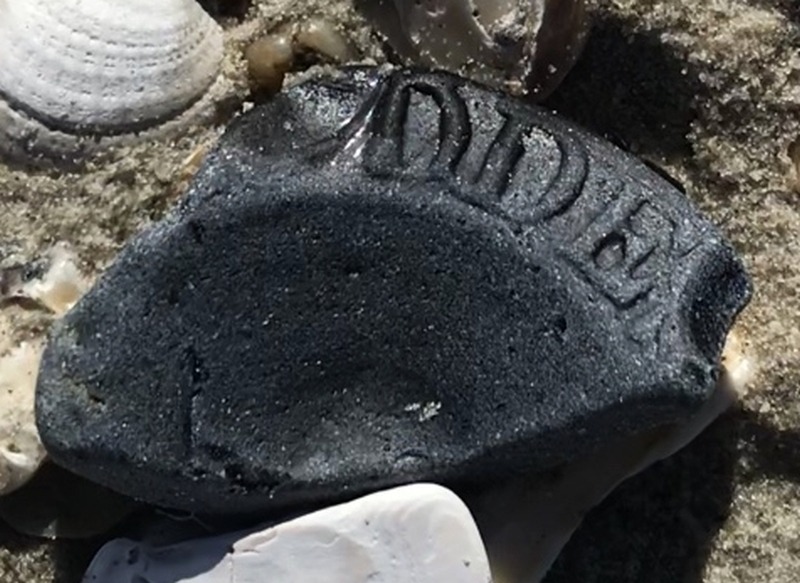
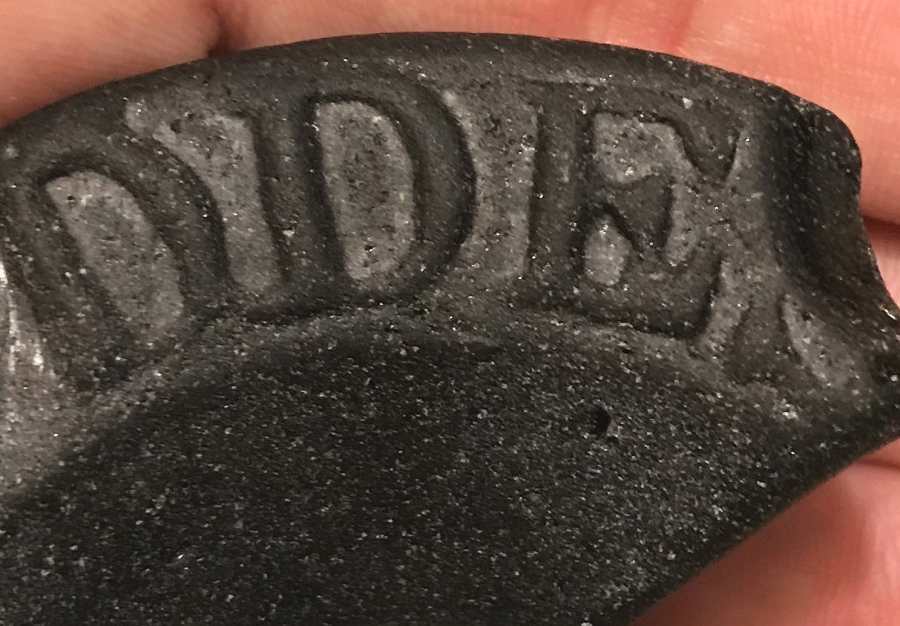
Sea glass is collected for it’s interesting colors and textures, for use as part of craft projects, for incorporating into jewelry, mosaics, art projects, etc. Sometimes collections are displayed in clear glass jars, bottles, fishbowls, brandy snifters or vases, with the glass grouped by single colors, or with a number of different colors mixed together. Sometimes the glass is picked up by a casual beachcomber purely out of curiosity as to where it came from, or what a piece might have originally been part of, and eventually this interest expands into a full-fledged hobby.
NOTE: A lot of the so-called “sea glass” sold on the internet is not “as found”, but was artificially created by using a rock tumbler or similar means. Fake sea glass is frequently sold on sites such as ebay, so proceed with caution if you are buying it online. The authentic product is very difficult to fake, and fake sea glass can usually be differentiated from authentic, natural sea glass, but only upon very close inspection.
Much more information can be found at the North American Sea Glass Association website here: https://seaglassassociation.org/.
For an extensive list of marks, logos and symbols that might be seen on pieces of beach glass (some with accompanying illustrations), please check out my “Glass Bottle Marks” pages.
Please click here to go to my “HOME PAGE”
ADVERTISEMENT


Hi! I’m trying to identify a thick black glass kickup with partial lettering along the bottom rim. Do the capital letters “…DDES…” ring a bell?
There’s a photo on my fb page:
[Edited 3/4/2025 – The original webpage link Kelly included of the photo is no longer working, but she sent two photos and I have them linked here for viewers – David]
https://glassbottlemarks.com/wp-content/uploads/2024/12/DDES-Blackglass-beach-glass-Shard-Kelly.jpg
https://glassbottlemarks.com/wp-content/uploads/2021/03/DDES-Blackglass-beach-glass-Shard-Kelly-2.jpg
Kelly, thanks for the link. Interesting shard. Sooner or later, someone will land on this site who recognizes the full name on the bottle, and can let us know also!
Take care,
David
I grew up in Burlington, Ont, a block from Lake Ontario. I’d follow our creek out to the water and could find beach glass in slabs that took two hands to carry home. I had no idea what treasures I had.
I’ve been collecting sea glass for years and have used your reference site for years. Tonight was the first time I’ve stumbled upon your sea glass section. I’m always using this site for bottle bottoms that I find on a regular basis. Thanks for the information.
Thank you Carmen! I appreciate the nice words!
David
Awesome information! Thanks. I do have a question. I was out on a beach and found 2 gumdrop looking glass pieces. Well frosted. But for some reason, my mind keeps telling me they are glass dropplets used in fake flower arrangements. Flatish on one side, domed and rounded nicely, but quite frosted. Is anyone finding these on the beach?? TNX
Alan, I wouldn’t be surprised to find almost ANY type of discarded glass in the form of “beach glass”. Who knows, someone could have dumped a handful of them at the beach (sometime in the last few years) just to start the process of making some neat beach glass! Those “flattened marbles” (“gemstones”, glass pebbles) have been around for quite awhile, made in many colors and sizes, at least as early as the 1970s. If anyone knows when they were first produced, let us know!
~David
How domed are we talking? I have a very pretty cobalt blue piece that sounds like what you described. It has a flat bottom and a rounded top, which could be described as “domed.” David’s “flattened marbles” definitely fits. While I never thought to research their origin, I just thought I’d mention that I have a whole container of non-sea,beach glass ones, of various colors (though not cobalt blue) that I’d used at the bottom of an aquarium. Now I’m curious about them, too, before someone decided they’d look cool in aquariums. It is not uncommon for me to end up on your site, David, when I’ve found a bottle bottom on the beach with enough of its markings for me to research, and it all began when I found my first piece of glass insulator last year.
Hi Renee,
I just discovered your post reply that had been diverted to the website spam folder. Sorry about the delay in answering. Again, I don’t know much about the “glass pebbles” or “flattened marbles” but I assume they have been used in crafts, floral arrangements, aquariums, etc at least since the late 1960s and probably before that. I found a large green one (about 1 and 1/2 inches in diameter) lying on the ground in a neighborhood alley in Tucson when I was a child, and that was in 1969, so we can be sure they were being made at least that early!
I know they are currently sold in large quantities in any hobby or craft store, (such as Hobby Lobby, Michael’s, etc) and the crafts/floral section of large department stores. I believe the majority, if not all, are now imported from Asia, especially China.
~David
Hi Alan, sounds like you may have found a “kick up” or “push up” The bottom of a wine bottle which was solid (present wine/champagne bottles have these but usually not solid) ends up looking like a gumdrop shape. Is it dark green? That’s the most common color of “kick ups”.
Linda
Thanks for this, a really interesting read. We’ve actually made a business out of sea glass by collecting it from the shores of the beach near our house and turning it into jewellery. It always seems to go down well with people because as well as looking very attractive, they immediately question where it came from. Thanks again. Kerry.
Thank you Kerry! I appreciate your post!
David
I love that bottle collectors are now into sea glass. I know that in our online sea glass group Seaglasslovers.ning.com, shard id is always welcome. We also have a group on facebook and members have made some amazing id’s of glass remnants. It really is like archeology, but on the beach. Who could ask for more…../
Thanks for the great article!
Thank you!
David
Would you be able to help me identify a large clear glass seal I found along the beach? My husband thinks it’s a dragon but I say boar. Any input would be greatly appreciated.
Hi Meagan,
It’s probably the bottom of a Gordon’s Gin bottle. Most (if not all) of the older versions have a representation of a “boar” on the base.
David
Hi David, the salinity of the water does have a strong effect on the patina formation in sea glass. There is a process of hydration where the saline water eventually starts to chemically interact with the glass. That’s one of the reasons (along with less wave action/friction) that freshwater entities tend to take so much longer to create beach glass. The hydration is apparent in the characteristic C shapes you see on true sea glass and is a helpful way to ensure authenticity. Craft glass (artificial sea glass) can be made by acid etching and it’s probably best not to handle it too much or use it in aquariums unless you know it’s safe.
Hi Mary,
I appreciate your input!! Thanks for the information you have posted.
Take care, David
I just wanted to say that I think it is cool that you have a section on beach/sea glass, because finding about a fist size piece of a glass insulator on the beach a couple of weeks ago is what landed me at glassbottlemarks.com. I had no idea what I had found, except that it was so very large, such a pretty aqua color, and such an unusual find, but my husband suddenly had a thought that proved to be correct. Unfortunately for an actual identification, I only found part of the upper portion of the insulator, not any of the bottom portion. Besides finding another large, though a bit smaller piece of another, slightly bluer, insulator (again, part of the upper portion), I have also made some fun finds the last few weeks that have had me back here, with your link to sha.org yielding me the info I needed for a few pieces of bottles, including a Heinz ketchup bottle made between 1880-1905. (I found 2/3 of a bottle bottom, so I had some good clues to work with, which is good, since I hadn’t bookmarked this page yet!) I just happened to notice this page while I was looking at info about the Owens-Illinois Glass Company. All I could come up to describe the funny mark in the middle of the small square brown bottle or jar bottom was that it looked like Saturn. Such a crazy Google search got me here…again. Next time, I’ll just start here! But I just happened to see you also through sea/beach glass into the discussion, which I obviously think is great, since I just wrote this whole long comment.
Thank you Renee, and I am glad you are finding my site useful! If you can take pics of the chunk of insulator, I might be able to identify the type it is from. Contact me directly at the email address as listed on the bottom right-hand corner of any page on this site.
Best regards,
David
Hi! I came across a piece of sea glass yesterday and have been scouring the internet for answers on what it could be! It is the bottom of a large clear bottle/jar, about 4 inches in diameter. It has large lettering across the center that says “S.C.B.” Along the side of the bottle, along the bottom edge, it says “providence R I” (If the bottle was standing up, it reads “providence R I” along the base, not on the actual bottom of the bottle) If anyone knows what this could be, I would appreciate any clues!
My husband & I started collecting sea glass & pottery… I really enjoy the hunt… In fact, last week I found a piece of pottery with a design on it… Went back a week later and my husband picked a piece of pottery with the same design… When we got home, to my amazement the both pieces fit like a glove!!
Thank you for the very interesting article on sea/beach glass! I am a newbie in collecting glass and pottery on the beach. I had ‘assumed’ that the glass and pottery came off of ships. Coming from inland rivers and streams makes much more sense. Thanks for posting so much helpful information.
Hi Lisa,
Thanks for your comment. Yes, tremendous amounts of floating debris, including natural stuff like wood (ranging from tiny sticks to entire huge tree trunks), leaves, grass, nuts & seeds, etc is carried down most of the world’s great river systems to the oceans, especially in “times of flood”, as anyone who lives next to a larger river during a flood event can attest. A lot of that ends up, sooner or later, along beaches as driftwood.
But an increasing amount of debris washing downstream is man-made. Glass bottles, though despised by some as unsightly trash, are relatively benign, and can end up being the much-loved beach glass! And if enough time elapses the glass eventually breaks down to components silica (main ingredient in sand), lime and other natural elements. The relatively modern scourge on our oceans is the proliferation of HUGE amounts of plastics, including plastic bottles, pieces of old plastic toys, styrofoam, plastic bags, cigarette lighters, bottle caps and hundreds of other items made of plastic.
The “litterbug mentality” of people in times past has actually contributed to much of the present-day fun and “neat finds” in the field of sea glass, but the future may not be so bright for beachcombing…….. with the increasingly higher percentage of non-degradable plastics being washed ashore!
Take care,
~David
Hi and thanks for your post!
~David
Quite an interesting article you write. Well, I should rephrase: Everything here is an interesting reading. I have one piece of beach glass I pulled out of an area of a shallow lake, I’m guessing it is early 1900s like most of the bottles I find there; and as there is so little wave-action, it must have taken awhile to create. I have no photos of it, or idea how to post them, but my question is: It is a very bent piece of white-clear glass that forms a kind of triangle and is curved so perfectly on two sides (third side bent inward) I don’t think that part was shattered– know what it once was? I’m guessing part of a window, or the base to a bottle, but do not know. The area was full of broken colored glass bottles, shards of clay roofing tiles, and tiles for walls/bathrooms. It was the only non-jagged piece there. I found a pitted jar-lid (glass) in there to to an Mason Jar. I hope you’ll be okay if I make many posts through your site as time goes on, as some things my bottle-insulator-pottery-jar friends probably will not know.
Hi Yogi, Thanks for the nice comments. I don’t have this site “set up” for readers to post photos (and it would get loaded down quickly with tons of pics if I did) but if you could, send me pics directly to my email address (listed on lower right hand corner of any page on this site), and I will see if I recognize the piece of glass you describe.
~David